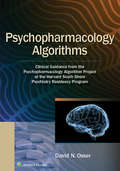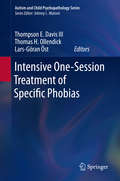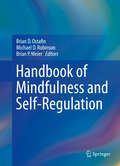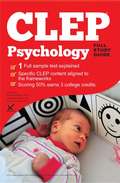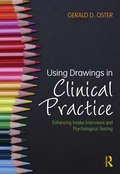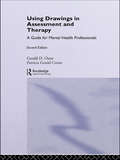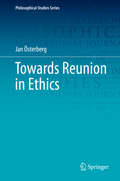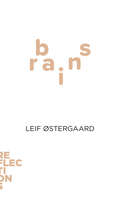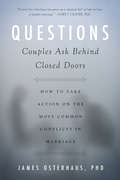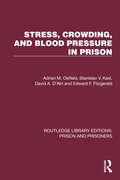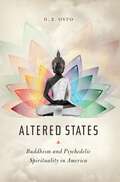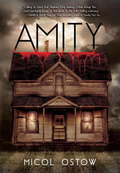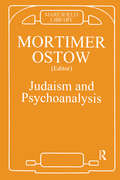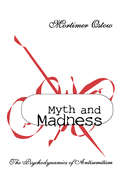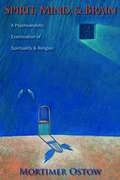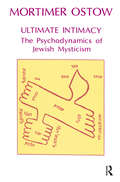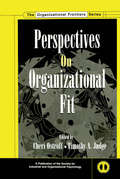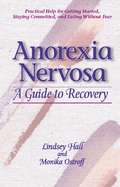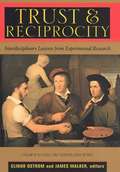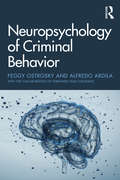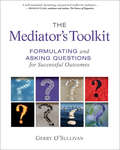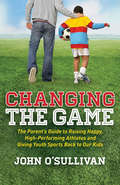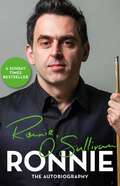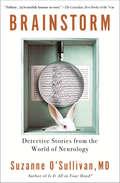- Table View
- List View
Psychopharmacology Algorithms: Clinical Guidance from the Psychopharmacology Algorithm Project at the Harvard South Shore Psychiatry Residency Program
by David OsserAlgorithms serve an important purpose in the field of psychopharmacology as heuristics for avoiding the biases and cognitive lapses that are common when prescribing for many conditions whose treatment is based on complex data. Unique in the field, this title compiles twelve papers from the Psychopharmacology Algorithm Project at the Harvard South Shore Psychiatry Residency Training Program and presents practical ways to adopt evidence-based practices into the day-to-day treatment of patients. Psychopharmacology Algorithms is a useful resource for practicing psychiatrists, residents, and fellows, as well as psychiatric nurse practitioners, psychiatric physician assistants who prescribe, advanced practice pharmacists who prescribe, and primary care clinicians. Teachers of psychopharmacology may find it particularly valuable. Researchers in clinical psychopharmacology may find it helpful in identifying important practice areas that are in need of further study.
Intensive One-Session Treatment of Specific Phobias
by Lars-Göran Öst Thompson E. Davis III Thomas H. OllendickWhether it's dogs, spiders, blood, heights or some other fear, specific phobias are one of the most prevalent mental health problems, affecting as many as one in eight people. In recent years, cognitive-behavioral therapy (CBT) has emerged as particularly effective in treating young people and adults with specific phobias. And of these methods, one-session treatment stands out as a long-lasting, cost-effective intervention of choice. Intensive One-Session Treatment of Specific Phobias not only provides a summary of the evidence base, it also serves as a practical reference and training guide. This concise volume examines the phenomenology, epidemiology, and etiology of phobias, laying the groundwork for subsequent discussion of assessment strategies, empirically sound one-session treatment methods, and special topics. In addition, expert contributors address challenges common to exposure therapy, offer age-appropriate guidelines for treating young clients, and describe innovative computer-assisted techniques. Organized to be read individually or in sequence, chapters delve into key areas, including: Evidence-based assessment and treatment of specific phobias in children, adolescents, and adults.One-session treatment theory and practice with children, adolescents, and adults.Handling difficult cases of specific phobias in youth.Interventions for specific phobias in special populations.Training and assessing therapists in one-session treatment.Ethical issues in considering exposure. Intensive One-Session Treatment of Specific Phobias is an essential resource for researchers, clinicians, and graduate students in child, school, clinical, and counseling psychology; social work; and general and special education.
Handbook of Mindfulness and Self-Regulation
by Brian D. Ostafin Michael D. Robinson Brian P. MeierThis empirically robust resource examines multiple ways mindfulness can be harnessed to support self-regulation, in part as a real-world component of therapy. Its authoritative coverage approaches complex mind/brain connections from neuroscience, cognitive, personality, social, clinical, and Buddhist perspectives, both within and outside traditional meditation practice. In domains such as letting go of harmful habits and addictions, dealing with depression and anxiety, regulating emotions, and training cognitive function, contributors show how mindfulness-based interventions encourage and inspire change. In addition to scientific coverage, experts translate their methods and findings on mindfulness mechanisms in terms that are accessible to students and clinicians. Included in the Handbook: Mindfulness and its role in overcoming automatic mental processes Burning issues in dispositional mindfulness research Self-compassion: what it is, what it does, and how it relates to mindfulness Mindfulness-based cognitive therapy and mood disorders Mindfulness as a general ingredient of successful psychotherapy The emperor's clothes: a look behind the Western mindfulness mystique Heralding a new era of mind/brain research--and deftly explaining our enduring fascination with mindfulness in the process--the Handbook of Mindfulness and Self-Regulation will enhance the work of scholars and practitioners.
CLEP College Level Examination Program: Psychology
by Kimberley O'Steen David Cornell John FletcherLike all 33 CLEP tests not only will passing a CLEP Psychology exam get you out of a course you will also get the college credits on your transcripts. Even more astounding the tests only require a 50% score. Perhaps your goal is to fast track out of the college experience and leap into the upper divisions that much quicker. A psychology degree is typically a master's level program at a minimum. The professional way to study for this test is with resource material such as XAMonline's CLEP Psychology full length study guide. It was written by one MD, one PhD, and one Masters level Psychologist which means it was concisely written so the essential material is conveniently brought into your living room for the next few weeks. All the multiple choice questions are full length tests and are weighted properly covering all aspects of the test. They also have the answers explained so you can learn as you go too. XAMonline full study guide for CLEP Psychology will prepare you for the test.
Using Drawings in Clinical Practice: Enhancing Intake Interviews and Psychological Testing
by Gerald D. OsterClinicians are always in need of enticing techniques to engage clients on a daily basis, especially those who are nonverbal or initially opposed to feedback. Using Drawings in Clinical Practice provides a rich variety of drawing directives to enhance the diagnostic process. In this highly illustrated text, clinicians will discover the tools they need to interact effectively with their clients. The book places special emphasis on intake interviewing and psychological testing, where the potential for uncovering hidden conflicts and therapeutic direction is especially poignant. Case studies provide a comprehensive overview of how to introduce simple drawings and gain remarkable insights. Using Drawings in Clinical Practice is a crucial guidebook for professionals who seek new ways to facilitate meaningful communication and interactions in their practice settings.
Using Drawings in Assessment and Therapy: A Guide for Mental Health Professionals
by Gerald D. Oster Patricia Gould CroneThis highly practical book provides useful drawing directives to clinicians involved in the assessment and treatment of individuals, families, and groups in both inpatient and outpatient settings. The authors present many case histories to show how the various aspects of drawing techniques can be integrated and applied in clinical practice. "Using Drawings in Assessment and Therapy" is vividly illustrated with over 90 drawings, which are used to describe how the therapeutic interaction can be enhanced by adding this method to the clinician's repertoire. This second edition condenses and synthesizes a variety of drawing directives that aid clinicians in the assessment process and in therapy. It also features updated literature reviews, with new case studies and accompanying art work. All therapists who are involved or interested in art therapy will gain a wealth of information, insight, and practical tips from this thorough volume.
Towards Reunion in Ethics (Philosophical Studies Series #138)
by Jan ÖsterbergThis posthumous publication attempts to answer the question of what moral code is the most reasonable. Philosophers often turn to consequentialism or deontological ethics to address this issue. As the author points out, each has valid arguments but each is unable to get the other side to agree. To rectify this, he proposes a third way. Inside, readers will discover a theory that tries to do justice to both sides. The author first details consequentialism and deontological ethics. He also explains their fundamental conflict. One holds the view that you should do what has the best consequences. The other believes that there are actions which are wrong to do even if they have the best consequences. Next, the volume considers various ways to solve this conflict. Would rejecting one theory work? Or, is it possible to somehow reconcile them. The author shows why these solutions fail. He then goes on to present his own. The resulting contractual theory brings together the two opposing ethical convictions. It proposes that what is right and wrong depends on what norms people would agree to. Throughout, coverage explores the psychological, sociological, and historical background of the moral theories discussed. The reason is that moral theories are embedded in social and psychological contexts. They are better understood when the contexts are explicit. This key feature distinguishes the volume from other works in moral philosophy.At the time of his death in July 2011, Jan Österberg was close to completing this manuscript. It was taken up and fully completed by Erik Carlson and Ryszard Sliwinski, both of Uppsala University.
Brains
by Leif ØstergaardA short but engaging exploration of the brain.In Brains, scientist Leif Østergaard explores our most complicated and mysterious organ. From the dissection of Einstein's brain to research on how to map networks of neurons, Østergaard deconstructs the different parts of the brain and provides an engaging overview of its essential functions. He explains how we store information in the synapses of neural networks and how these networks carry commands to our muscles and internal organs and receive sensory input from our skin, eyes, ears, nose, and mouth. Delving into the subconscious, we learn what our brains are doing while we daydream and how neurotransmitters play a role in addiction. In this fascinating book, Østergaard reveals how this enigmatic organ is even more complex than we thought it was.In Reflections, a series copublished with Denmark's Aarhus University Press, scholars deliver 60-page reflections on key concepts. These books present unique insights on a wide range of topics that entertain and enlighten readers with exciting discoveries and new perspectives.
Questions Couples Ask Behind Closed Doors: How to Take Action on the Most Common Conflicts in Marriage
by James OsterhausThe "What is 'healthy'?" question is just one of many questions couples have asked me over and over again in my counseling practice. The typical couples I've counseled have again and again asked, "Why do we get into so much conflict over the same issues?" "How can we learn to trust each other?" "Who leads?" "What do we do with in-laws?" and a whole host of other questions. Noted marriage therapist and executive coach Jim Osterhaus takes the 18 top questions he's been asked the most and answers them for you in this book. Each chapter stands on its own as couples search for answers to the challenges they face. After many of the chapters, you will find very helpful, practical tips to help you understand your relationship better, and begin the process of making it more fulfilling.
Stress, Crowding, and Blood Pressure in Prison (Routledge Library Editions: Prison and Prisoners)
by Adrian M. Ostfeld Stanislav V. Kasl David A. D'Atri Edward F. FitzgeraldOriginally published in 1987, the purpose of Stress, Crowding, and Blood Pressure in Prison was to present, in a single location, the rationale, background, methods, principal results, analyses, interpretations, and conclusions of the authors’ studies at Massachusetts correctional institutions. Employing a longitudinal method for studying 568 inmates, the authors drew on psychological, social and health sciences assessments to identify the effects of housing mode, prison employment, leisure activities, disciplinary actions, and personal and sociodemographic characteristics to identify what was particularly stressful for inmates. A parallel study of prison staff and a specific series of conclusions and recommendations concludes the book.
Altered States: Buddhism and Psychedelic Spirituality in America
by Douglas OstoIn the 1960s, Americans combined psychedelics with Buddhist meditation to achieve direct experience through altered states of consciousness. As some practitioners became more committed to Buddhism, they abandoned the use of psychedelics in favor of stricter mental discipline, but others carried on with the experiment, advancing a fascinating alchemy called psychedelic Buddhism. Many think exploration with psychedelics in Buddhism faded with the revolutionary spirit of the sixties, but the underground practice has evolved into a brand of religiosity as eclectic and challenging as the era that created it. <P><P>Altered States combines interviews with well-known figures in American Buddhism and psychedelic spirituality—including Lama Surya Das, Erik Davis, Geoffrey Shugen Arnold Sensei, Rick Strassman, and Charles Tart—and personal stories of everyday practitioners to define a distinctly American religious phenomenon. The nuanced perspective that emerges, grounded in a detailed history of psychedelic religious experience, adds critical depth to debates over the controlled use of psychedelics and drug-induced mysticism. The book also opens new paths of inquiry into such issues as re-enchantment, the limits of rationality, the biochemical and psychosocial basis of altered states of consciousness, and the nature of subjectivity.
family
by Micol Ostowi have always been broken. i could have. died. and maybe it would have been better if i had. It is a day like any other when seventeen-year-old Melinda Jensen hits the road for San Francisco, leaving behind her fractured home life and a constant assault on her self-esteem. Henry is the handsome, charismatic man who comes upon her, collapsed on a park bench, and offers love, a bright new consciousness, and-best of all-a family. One that will embrace her and give her love. Because family is what Mel has never really had. And this new family, Henry#x19;s family, shares everything. They share the chores, their bodies, and their beliefs. And if Mel truly wants to belong, she will share in everything they do. No matter what the family does, or how far they go. Told in episodic verse, family is a fictionalized exploration of cult dynamics, loosely based on the Manson Family murders of 1969. It is an unflinching look at people who are born broken, and the lengths they#x19;ll go to to make themselves #x1C;whole#x1D; again.
Judaism and Psychoanalysis
by Mortimer OstowIs psychoanalysis a "Jewish science"? Ten essays contributed by the editor and distinguished scholars explore the Jewishness of psychoanalysis, its origins in the Jewish situation of late nineteenth century Europe, Freud's Jewishness and the Jewishness of his early colleagues. They also exemplify what the psychoanalytic approach can contribute to the study of Judaism. Clinical studies illuminate the issue of Jewish identity and psychological significance of the bar mitzvah experience. Theoretical essays throw light on Jewish history, Jewish social and communal behavior, Jewish myths and legends, religious ideas and thoughts.What are the major determinants of Jewish identity? What is the role of Jewish education in establishing and maintaining Jewish identity? What does the Midrash tell us about the meaning of anxiety to the traditional Jew, and how does Judaism attempt to deal with anxiety? What strategies have Jews used to survive an anti-Jewish world? Under what circumstances has the compliant posture of Johanen ben Zakkai been celebrated, and under what circumstances the defiance of the martyrs of Massada?
Myth and Madness: The Psychodynamics of Anti-Semitism
by Mortimer OstowThe persistence of anti-Semitism and its current resurgence after a brief post-Holocaust suppression, challenge those who study human behavior to locate the causal bases of anti-Semitism and find approaches to combat it. This is an astonishing report of a nine-year study of the psychodynamics of anti-Semitism. Undertaken by Dr. Mortimer Ostow on behalf of the Psychoanalytic Research and Development Fund, it puts flesh and bones on the discussion of antisemitism in Sigmund Freud's 1939 classic theoretical study Moses and Monotheism. Its close adherence to case material, and application of psychoanalytic theory to historical data and cultural products, yields new insights into bigotry and equity alike.By examining prejudiced patients and their myths, Dr. Ostow shows the common threads of anti-Semitism in a variety of national and cultural settings, even under supposed optimal conditions when antisemitism is stringently controlled. The work uses the psychiatric approach, and can be read as a study of how this area of behavioral science reveals the interplay of the individual and the group, cultural background and material opportunities.The book is divided into five major segments: Psychoanalytic interpretation of anti-Semitism in the past; clinical data on anti-Semitic sentiments in a variety of personal and national settings; mythological dimensions of anti-Semitism and apocalyptic doctrines; specific anti-Semitic myths including pre-Christian early and medieval Christian, "racial" and post-modern Muslim anti-Semitism. The final segment focuses on the pogrom mentality, including the Nazi phenomenon, antisemitic fundamentalism, and black anti-Semitism.Myth and Madness is informed by an amazing breadth of learning: from biblical exegesis to modern sociology, from close attention to mundane patients to evaluating mythic claims of the loftiest, and at times most dangerous sort. This is a landmark effort—one that will be the touchstone for theoretical and clinical works to come.
Spirit, Mind, and Brain: A Psychoanalytic Examination of Spirituality and Religion (Columbia Series in Science and Religion)
by Mortimer OstowPreeminent psychoanalyst Mortimer Ostow believes that early childhood emotional attachments form the cognitive underpinnings of spiritual experience and religious motivation. His hypothesis, which is verifiable, relies on psychological and neurobiological evidence but is respectful of the human need for spiritual value. Ostow begins by classifying the three parts of the spiritual experience: awe, Spirituality proper, and mysticism. After he pinpoints the psychological origins of these feelings in infancy, he discusses the foundations of religious sentiment and practice and the brain processes associated with spiritual experience. He then focuses on spirituality's relationship to mood regulation, and the role of negative spirituality in fostering religious fundamentalism and demonic possession.Ostow concludes with an analysis of an essay by the psychoanalyst Donald M. Marcus, who recounts his own spiritual experience during a Native American-style "vision quest" in the woods. Marcus's account demonstrates the constructive potential of spirituality and the way in which spirituality retrieves and recapitulates feelings of attachment to the mother.Persuasively and brilliantly argued, Spirit, Mind, and Brain brings the disciplines of religion, behavorial neuroscience, and philosophy to bear on a groundbreaking new method for understanding religious ritual and belief.
Ultimate Intimacy: The Psychodynamics of Jewish Mysticism
by Mortimer OstowThis book introduces the psychoanalytic study of the Kabbalah as a serious discipline. It illustrates the applicability of psychodynamic concepts to Jewish mysticism and the "apocalyptical complex" and essays on specific incidents in the Bible and the Kabbalah.
Perspectives on Organizational Fit (Siop Organizational Frontiers Ser.)
by Cheri Ostroff Timothy A. JudgeThis book concerns how employees consider their work lives, how well they fit their jobs, the work setting, other people, and what is important and valued in their organizations. Perspectives on Organizational Fit, a new book in SIOP's Organizational Frontiers Series, takes a scholarly look at fit in organizations: the relationship between individu
Anorexia Nervosa
by Monika Ostroff Lindsey HallAnorexia nervosa, in simple terms, is self-starvation. However, it is a complex problem with intricate roots; and, recovery is best accomplished with a grasp of sound information, specific tasks, and the support of others. All of that is provided in this guidebook, which includes: Answers to questions most often asked Insight from recovered and recovering Monika Ostroff's story of recovery Specific things to do that have worked Information on healthy eating and weight Suggestions for how to stay committed A special section for parents & loved ones
Trust and Reciprocity: Interdisciplinary Lessons for Experimental Research
by Elinor Ostrom James WalkerTrust is essential to economic and social transactions of all kinds, from choosing a marriage partner, to taking a job, and even buying a used car. The benefits to be gained from such transactions originate in the willingness of individuals to take risks by placing trust in others to behave in cooperative and non-exploitative ways. But how do humans decide whether or not to trust someone? Using findings from evolutionary psychology, game theory, and laboratory experiments, Trust and Reciprocity examines the importance of reciprocal relationships in explaining the origins of trust and trustworthy behavior. In Part I, contributor Russell Hardin argues that before one can understand trust one must account for the conditions that make someone trustworthy. Elinor Ostrom discusses evidence that individuals achieve outcomes better than those predicted by models of game theory based on purely selfish motivations. In Part II, the book takes on the biological foundations of trust. Frans de Waal illustrates the deep evolutionary roots of trust and reciprocity with examples from the animal world, such as the way chimpanzees exchange social services like grooming and sharing. Other contributors look at the links between evolution, cognition, and behavior. Kevin McCabe examines how the human mind processes the complex commitments that reciprocal relationships require, summarizing brain imaging experiments that suggest the frontal lobe region is activated when humans try to cooperate with their fellow humans. Acknowledging the importance of game theory as a theoretical model for examining strategic relationships, in Part III the contributors tackle the question of how simple game theoretic models must be extended to explain behavior in situations involving trust and reciprocity. Reviewing a range of experimental studies, Karen Cook and Robin Cooper conclude that trust is dependent on the complex relationships between incentives and individual characteristics, and must be examined in light of the social contexts which promote or erode trust. As an example, Catherine Eckel and Rick Wilson explore how people's cues, such as facial expressions and body language, affect whether others will trust them. The divergent views in this volume are unified by the basic conviction that humans gain through the development of trusting relationships. Trust and Reciprocity advances our understanding of what makes people willing or unwilling to take the risks involved in building such relationships and why. A Volume in the Russell Sage Foundation Series on Trust
Neuropsychology of Criminal Behavior
by Feggy Ostrosky Alfredo ArdilaThis book draws on findings from psychology, neurology, and genetics, to offer a multi-dimensional analysis of criminal behavior. It explores the biological bases of emotions such as aggression, anger, and hostility and how they-- combined with social psychological influences, such as family history and environmental conditions-- may lead to violence. Specific case studies, including serial killings, mass murders, family violence, cannibalism, and hitmen, are referenced throughout, providing real-world examples of these theories in action. Issues of free will and the law are discussed as well as suggestions for curbing violent behavior.
The Mediator's Toolkit: Formulating and Asking Questions for Successful Outcomes
by Gerry O'Sullivan“Dives deep into the psychology of information and emotion in conflict situations . . . Highly recommended for facilitators and negotiators as well as mediators.” —Jennifer Beer, author of The Mediator’s Handbook and negotiation instructor at Wharton School, University of PennsylvaniaKnowing how to formulate and ask incisive questions to get to the core of a conflict, challenge entrenched thinking, and shift perspectives is the key to successful conflict resolution. The Mediator’s Toolkit employs the author’s powerful “S Questions Model” to provide readers with the skills and tools to do just that. It addresses four dimensions of successful questions for mediation: the subject matter dimension, the structure dimension, the information-seeking dimension, and the shifting thinking dimension. The toolkit clearly explains:The theory behind each question type, including exploration of relevant neuroscience and psychologyThe purpose of different types of questionsHow the questions workWhen to use different types of questionsHow to build and apply questions to mediation in a non-threatening wayThis essential practical guide will radically sharpen, focus, and improve the questioning skills of qualified mediators, students, lecturers, trainers, and those using questions to challenge and effect change, in any context.
Changing the Game: The Parent's Guide to Raising Happy, High-Performing Athletes and Giving Youth Sports Back to Our Kids
by John O'SullivanPERPERience to take us behind the scenes of competitive youth sports, and demonstrates how they have changed from being a fun pastime to an ultra competitive, adult centered enterprise that is failing our children.
Ronnie: The Autobiography of Ronnie O'Sullivan
by Ronnie O'SullivanRonnie is snooker's most written and talked about player, and its greatest showman. His supreme talent and style have made him the People's Champion and, as one commentator put it, 'the question is not how much does Ronnie O'Sullivan need snooker, but how much does snooker need Ronnie O'Sullivan?' A honest and candid account of his extraordinary life, Ronnie tells of the infant who was introduced to legendary snooker clubs at an impossibly early age; of the boy who frightened off the bookies aged just 12; of the teenager whose life was decimated when his father and mentor was sent to prison for life; and of the man dubbed the 'genius' of the modern game who regularly threatened to quit the sport to pursue other interests at the grand old age of 28.'A fine autobiography ... compelling' - Independent'O'Sullivan is as frank about his spell in the Priory clinic as he is about his father's murder conviction. His accounts of snooker tournaments and sketches of the sport's personalities will fascinate fans, but even snooker haters will be rooting for Ronnie in the game of life' - OK!
Ronnie: The Autobiography of Ronnie O'Sullivan
by Ronnie O'SullivanRonnie is snooker's most written and talked about player, and its greatest showman.His supreme talent and style have made him the People's Champion and, as one commentator put it, 'the question is not how much does Ronnie O'Sullivan need snooker, but how much does snooker need Ronnie O'Sullivan?' A honest and candid account of his extraordinary life, Ronnie tells of the infant who was introduced to legendary snooker clubs at an impossibly early age; of the boy who frightened off the bookies aged just 12; of the teenager whose life was decimated when his father and mentor was sent to prison for life; and of the man dubbed the 'genius' of the modern game who regularly threatened to quit the sport to pursue other interests at the grand old age of 28.'A fine autobiography ... compelling' - Independent'O'Sullivan is as frank about his spell in the Priory clinic as he is about his father's murder conviction. His accounts of snooker tournaments and sketches of the sport's personalities will fascinate fans, but even snooker haters will be rooting for Ronnie in the game of life' - OK!
Brainstorm: Detective Stories from the World of Neurology
by Suzanne O'SullivanA leading neurologist recounts some of her most astonishing, challenging cases, which demonstrate how crucial the study of epilepsy has been to our understanding of the brain.Brainstorm follows the stories of people whose medical diagnoses are so strange even their doctor struggles to know how to solve them. A man who sees cartoon characters running across the room; a girl whose world suddenly seems completely distorted, as though she were Alice in Wonderland; another who transforms into a ragdoll whenever she even thinks about moving.The brain is the most complex structure in the universe. Neurologists must puzzle out life-changing diagnoses from the tiniest of clues, the ultimate medical detective work. In this riveting book, Suzanne O'Sullivan takes you with her as she tracks the clues of her patients' symptoms. It's a journey that will open your eyes to the unfathomable intricacies of our brains and the infinite variety of human experience.
